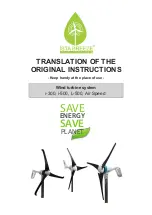
Document No. 1112M001 Revision 1.8 Date: June 2013
42
and in many cases the user may already have a good feel for the
winds in the locality. However impressions can be deceptive.
A more reliable way to evaluate the wind resource, which is strongly
recommended when there is doubt over whether the wind is strong
enough, is to take regular measurements over a period of several
months, preferably a year. It is not straightforward to use data even
from nearby sites, and probably the nearest meteorological station or
airfield where records have been kept is many miles away. However,
measurements taken at a proposed site can be compared with
measurements taken elsewhere at the same time, and used as a guide
to the probable correlation over longer periods. In addition computer
models re available for professionals to use, although such predictions
should be applied with care.
a) Get a reliable estimate of the wind speed at the proposed site.
b) Mount the turbine on as high a tower as possible and well clear of
obstructions, but do not go to extremes. Easy access will be
required for erection, and foundations for the tower may be needed
depending on the size and tower type. It is also important to ensure
that the wind turbine can be easily lowered for inspection and
maintenance.
c) Try to have a clear, smooth fetch to the prevailing wind, e.g. over
open water, smooth ground or on a smooth hill.
d) Use cable of adequate current carrying capacity (check with the
turbine supplier. This is particularly important for low voltage
machines). Cable costs can be substantial.
e) Consult your local authority as to whether you need planning
permission. You should try to minimise the environmental impact of
the turbine, and it will be helpful to inform your neighbours of your
plans at an early stage.




























